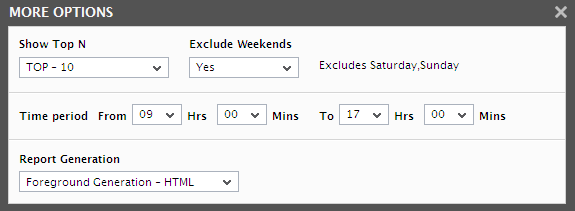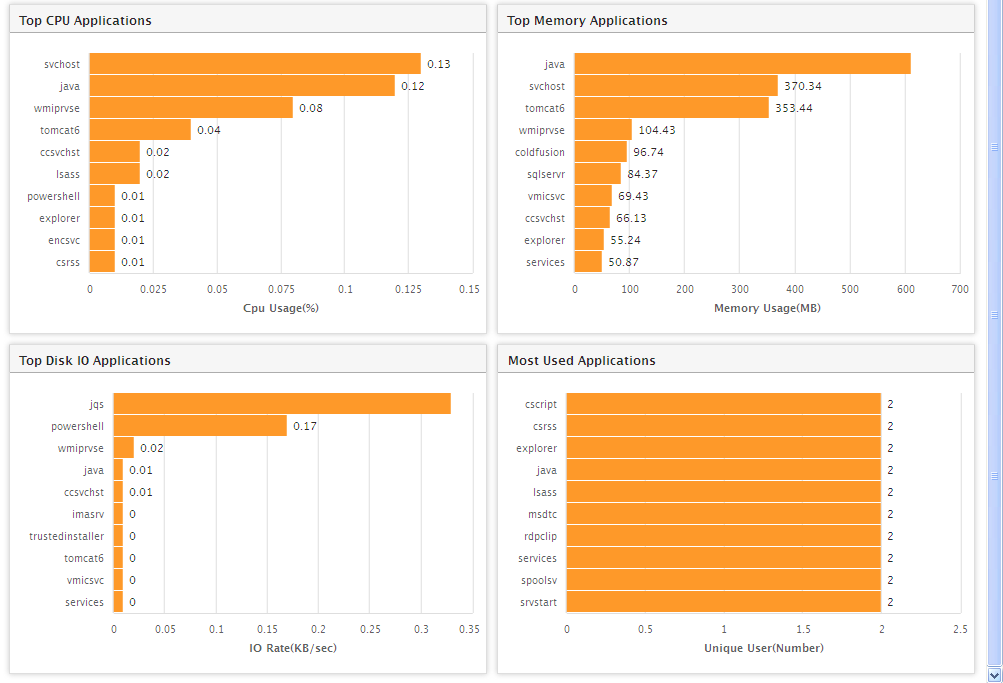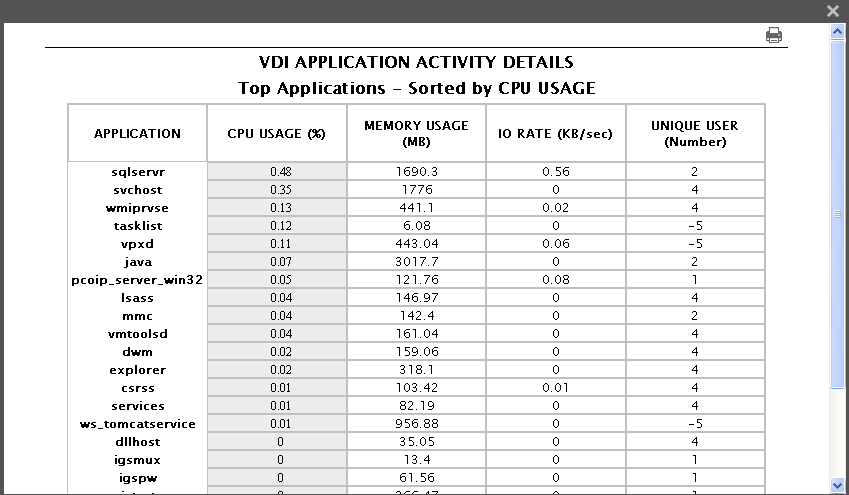VDI Resource Usage-Top Applications Report
In order to figure out the applications that are extensively used in the VDI environment, use the VDI Resource Usage-Top Applications report.
To generate the VDI Resource Usage-Top Applications report, do the following:
- Select the Top Applications option by following the menu sequence: REPORTS BY FUNCTION -> Domain-specific Reports -> Virtual Applications / Desktops-> VDI Resource Usage.
-
will then appear. Select an option for analysis of the report from the Analyze by list. By default, this list will display Component as its selection. You can however narrow your search by opting to view only those virtual servers that are part of a service/segment/zone. For this, select the Zone, Service, or Segment, option from the Analyze by field:
- Selecting the Zone option will allow you to select the desired zone from the Zone list box. To include the virtual servers within a specific subzone, set the Include subzones flag to Yes.
-
In the same way, to make the virtual servers that are part of a particular segment or service, select Service or Segment from the Analyze by list box. Then, select the desired service or segment from the Service or Segment list.

Figure 1 : Selecting the criteria for the VDI Resource Usage-Top Applications report
- Next, from the Component Type list, select the virtual server type for which this report is to be generated.
- In the Component list box, all the components pertaining to the chosen Component Type will be listed. If the Component list consists of too many virtual servers, then viewing all the components and selecting the ones you need for report generation could require endless scrolling. To avoid this, you can click the
 button next to the Component list. The COMPONENTS pop up window will then appear using which you can view almost all the virtual servers in a single interface and Select the ones for which the report is to be generated. If there are still too many components in the list to choose from, you can narrow your search further by using the Search Components text box. Specify the whole/part of the component name to search for in this text box, and click the icon next to it. The Component list will then be populated with all component names that embed the specified search string. Select the component of your choice from this list.
button next to the Component list. The COMPONENTS pop up window will then appear using which you can view almost all the virtual servers in a single interface and Select the ones for which the report is to be generated. If there are still too many components in the list to choose from, you can narrow your search further by using the Search Components text box. Specify the whole/part of the component name to search for in this text box, and click the icon next to it. The Component list will then be populated with all component names that embed the specified search string. Select the component of your choice from this list. -
Using the Weighted Average flag, you can indicate how the Avg value is to be computed for a chosen measure for the purpose of this report. The status of the Weighted Average flag is relevant only if the Test chosen is a descriptor-based test, and the descriptors are dynamic in nature. For instance, the VDI Applications test in our example auto-discovers the applications that are currently available on the virtual desktop. For each application that is discovered, the test reports a variety of statistics. Unlike descriptors such as disk partitions or processors that rarely change, the applications are dynamic descriptors, which may change often; in other words, an application that is used by the virtual desktop user now, may not be used by the user during the next measurement period. The VDI Applications test will neither report metrics for the inactive descriptors nor display it in the eG monitoring console. This is why, applications are considered 'dynamic descriptors'.
By default, the VDI Application Activity report compares the Avg value of the chosen measure across all selected descriptors. Since the Weighted Average flag is set to No by default, this Avg is computed as the ratio of the sum total of the measure values reported by a descriptor during the given timeline and the total number of times the test ran during the same timeline. In case of dynamic descriptors however, the Avg values so computed may not reveal the 'true picture of performance'. This is because, the test may not discover or report metrics for dynamic descriptors throughout a given timeline. For example, take the case of the VDI Applications test. Say, the test auto-discovered two applications - namely, 'explorer' and 'java' - during its first measurement period; both applications registered a memory usage of 30 MB and 60 MB respectively. Assume that the second time the VDI Applications test ran, it captured 50 MB of data for the application 'explorer’. Application 'java' however was inactive during the second measurement period, and hence, was not discovered at all. If the Weighted Average flag is set to No by default, then, the VDI Application activity report will plot the Avg value of 40 MB (30+50=80/2=40) for the application 'explorer' and 30 MB (60/2=30) again for the application 'java'. If you notice, unlike the application 'explorer', where 40 MB of data was transacted over a period of time, in case of the application 'java', 60 MB of data was transacted at one shot! Logically therefore, the application 'java' has to be ranked above the application 'explorer' in terms of memory usage. However, since the default Avg value computation does not clearly bring out this difference, both the applications 'explorer' and 'java' are treated at par in the VDI Application Activity report! This is why, in case of dynamic descriptors, you may want to set the Weighted Average flag to Yes. In this case, the eG Enterprise system expresses Avg as the ratio of the sum total of the measure values reported by a descriptor during a given timeline and the 'total number of times that descriptor was active' during the same timeline. This implies that if the Weighted Average flag is set to Yes in the application example above, the Avg value for the application 'explorer' will continue to be 40 (30+50=80/2=40), but the same for the application 'java' will be 60 MB (60/1=60). In the VDI APPLICATION ACTIVITY report therefore, the application 'java' will be placed above the application 'explorer', thereby accurately pointing you to the top applications that are consuming too much of memory resources.
-
Specify the report Timeline. You can either provide a fixed time line such as 1 hour, 2 days, etc., or select the Any option from the list to provide a From and To date/time for report generation.
Note:
For every user registered with the eG Enterprise system, the administrator can indicate the maximum timeline for which that user can generate a report. Once the maximum timeline is set for a user, then, whenever that user logs into eG Reporter and attempts to generate a report, the Timeline list box in the report page will display options according to the maximum timeline setting of that user. For instance, if a user can generate a report for a maximum period of 3 days only, then 3 days will be the highest option displayed in the Timeline list - i.e., 3 days will be the last option in the fixed Timeline list. Similarly, if the user chooses the Any option from the Timeline list and proceeds to provide a start date and end date for report generation using the From and To specifications, eG Enterprise will first check if the user's Timeline specification conforms to his/her maximum timeline setting. If not, report generation will fail. For instance, for a user who is allowed to generate reports spanning over a maximum period of 3 days only, the difference between the From and To dates should never be over 3 days. If it is, then, upon clicking the Run Report button a message box will appear, prompting the user to change the From and To specification.
-
In addition to the settings discussed above, this report comes with a set of default specifications. These settings are hidden by default. If you do not want to disturb these default settings, then you can proceed to generate the report by clicking the Run Report button soon after you pick the criteria for generating the report. However, if you want to view and then alter these settings (if required), click on the
 button. The default settings will then appear in the MORE OPTIONS drop down window (see Figure 2). The steps below discuss each of these settings and how they can be customized.
button. The default settings will then appear in the MORE OPTIONS drop down window (see Figure 2). The steps below discuss each of these settings and how they can be customized.
Figure 2 : The default settings for generating the User Logon Performance report
- By default, this report will list the activity of the Top 10 applications. If you wish to view the report for the number of applications of your choice, then, you may do so by selecting an option from the Show Top N list box.
-
If the timeline specified for the report needs to exclude the data collected during the Weekends, then set Exclude weekends to Yes. If not, select No.
Note:
By default, the weekend constitutes Saturday and Sunday. To override this default setting, do the following:
- Edit the eg_report.ini file in the <EG_INSTALL_DIR>\manager\config directory.
- In the [measure_group] section of the file, the exclude_weekend parameter is set to Saturday,Sunday by default. You can modify this by setting the exclude_weekend parameter to a comma-separated list of other days of the week - say Friday,Saturday.
- Save the file after making the required changes.
- Specify the start time and end time for report generation against the Time period field (see Figure 2).
-
In large environments, reports generated using months of data can take a long time to complete. Administrators now have the option of generating reports on-line or in the background. When a report is scheduled for background generation, administrators can proceed with their other monitoring, diagnosis, and reporting tasks, while the eG manager is processing the report. This saves the administrator valuable time. To schedule background processing of a report, select the Background Save - PDF option from the Report Generation list. In this case, a Report Name text box will appear, where you would have to provide the name with which the report is to be saved in the background. To process reports in the foreground, select the Foreground Generation - HTML option from this list.
Note:
- The Report Generation list will appear only if the EnableBackgroundReport flag in the [BACKGROUND_PROCESS] section of the eg_report.ini file (in the [EG_INSTALL_DIR]\manager\config directory) is set to Yes.
- The default selection in the Report Generation list will change according to the Timeline specified for the report. If the Timeline set is greater than or equal to the number of days specified against the MinDurationForReport parameter in the [BACKGROUND_PROCESS] section of the eg_report.ini file, then the default selection in the Report Generation list will be Background. On the other hand, if the Timeline set for the report is lesser than the value of the MinDurationForReport parameter, then the default selection in the Report Generation list will be Foreground. This is because, the MinDurationForReport setting governs when reports are to be processed in the background. By default, this parameter is set to 2 weeks - this indicates that by default, reports with a timeline of 2 weeks and above will be processed in the background.
-
Finally, click the Run Report button. Figure 3 will now appear.

- The generated report comprises of four different graphical sections (see Figure 3) – each comprising a bar chart for the Top CPU Applications, the Top Memory Applications, the Top Disk IO Applications and the Most Used Applications. The Top CPU Applications section lists the applications that are currently consuming high CPU resources. The Top Memory Applications section lists the applications that are currently consuming too much of memory resources. The Top Disk IO Applications lists the applications whose IO activity on the disk is higher and the Most Used Applications lists the number of instances of each application on the virtual desktops available in the target environment.
-
Clicking on any application of a particular bar chart will open a VDI Application Activity Details pop up window that lists all the usage statistics for each application. The data report will be sorted in descending order of the usage statistics of the application that was clicked on originally i.e., the sorting order of the data report will be based on the section of the bar graph that was clicked by the user. The Top Applications – Sorted by field will display the section of the bar chart that was originally clicked. Figure 4 shows a data report that appears when a bar of the Top CPU Applications section of Figure 3 is clicked.

Figure 4 : The VDI Application Activity Details pop up window that appears upon clicking the Top CPU Applications
